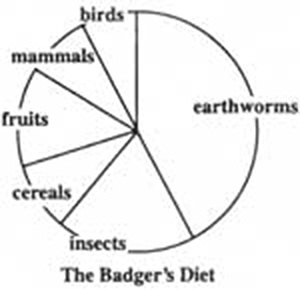THE BADGER’S DIET
Although the badger’s favourite food is worms, the diet chart shows that badgers are omnivorous. They will eat anything they can reach or catch, be it alive or dead. The size of their feeding range depends on the density of worms in the soil. They generally need about 200 worms a night.
In ideal conditions there may be 100,000 worms per acre (0.4ha). In drier areas it will be less and the badgers will have to travel further afield to find enough food. In frosty or dry weather worms are driven down into the soil – out of the badger’s reach and they must turn to other sources of food.
Badgers have been known to forage over as much as 30 acres (12ha) in poor conditions. The shape and flexibility of a badger’s snout helps it to ‘hoover’ up worms from the grass. Badgers derive a lot of their water from juicy worms and the dew they imbibe with them but they need sources of water. If these dry up, the badgers are forced to roam further.

